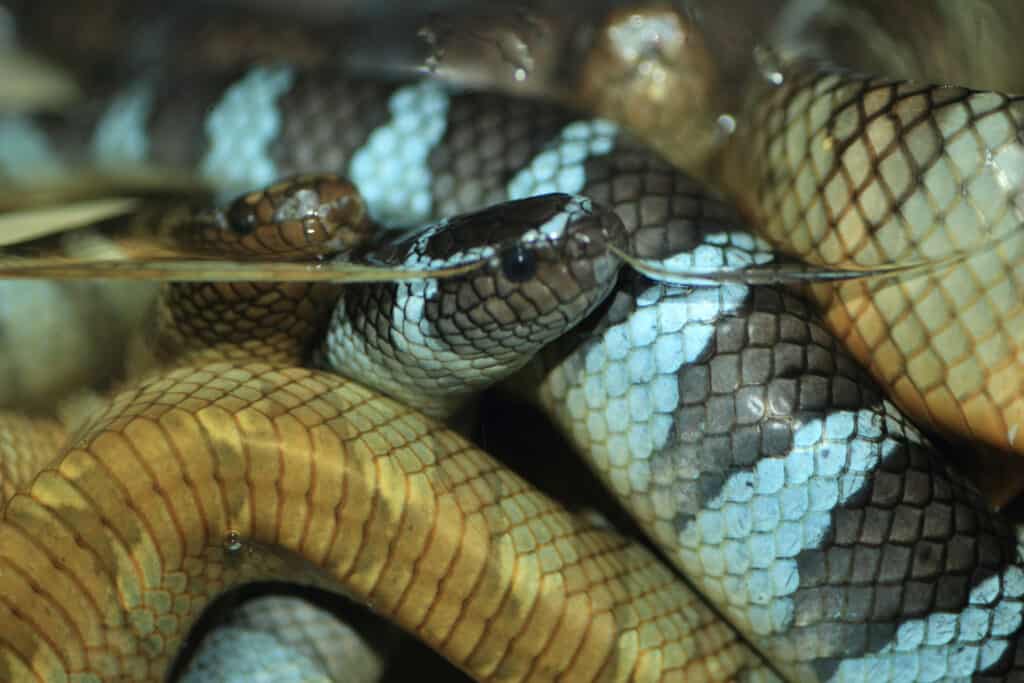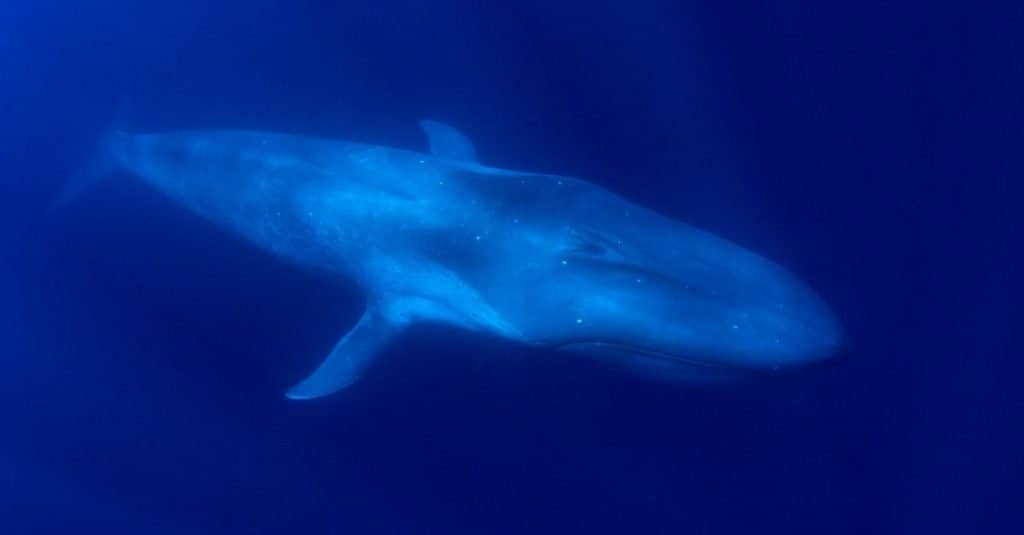King cobra venom can bring down an elephant, given enough time. The interesting thing about that situation is that a king cobra’s venom isn’t among the top five deadliest venoms in terms of LD50. That measure refers to the amount of venom killing half a test group’s animals. Many sea snakes have more potent venom than a king cobra. So, could a pack of venomous sea snakes kill a blue whale, the largest creature in the ocean?
We’re going to investigate this hypothetical situation and see what it would take for venomous sea snakes to bring down a blue whale or even if such a thing is possible. For this particular case, we will use information from the black-banded sea krait, a unique sea snake that hunts in large packs.
Let’s start by looking at this deadly krait and see why it might stand a chance at killing the world’s largest mammal.
The Black-Banded Sea Krait’s Venom

The black-banded sea krait can administer 0.111 mg/kg of venom and a total yield between
2 and 15 mg
per bite.
©feathercollector/Shutterstock.com
The black-banded sea krait is known for two things. First, it has powerful venom with an LD50 value of 0.111 mg/kg and a total venom yield between 2 and 15 mg per bite. Remember that a king cobra has an LD50 value of 1.8 mg/kg.
Thus, the black-banded sea krait’s venom packs more punch, but the King Cobra also injects up to 500 mg per bite compared to about 15 mg from the sea snake.
Keep in mind that the following is rough math, simply to give you an idea of how much venom a black-banded sea krait can administer in a bite.
Since the average human weighs roughly 154 pounds or 70 kg, we just need to multiply the LD50 value of 0.111 mg/kg by 70 kg to find that only 7.77 mg of venom is needed to kill a person. Since the snake can deliver up to 15 mg of venom at a time, one snake bite could almost certainly kill about 2 people.
Of course, that is simplifying matters and not considering many factors like multiple bites and the type of venom. After all, this sea snake’s venom is both neurotoxic and myotoxic. The toxin impacts the nervous system while also causing significant tissue damage.
Yet, it’s less significant if you apply the same math to a single blue whale. However, the black-banded sea krait isn’t like most snakes.
The Black-Banded Sea Krait Hunts in Groups

A Banded sea krait (
Laticauda colubrina) swims through shallow waters in the western Pacific.
©Ethan Daniels/Shutterstock.com
We know that a lone black-banded sea krait is not enough to kill a blue whale. Yet, this species is known for hunting in large groups around ocean reefs in the Pacific and Indian Oceans. The snakes participate in an interesting symbiosis where they allow fish to swim ahead of them toward the reefs, causing their potential prey to take shelter in their crevices.
That’s when the slower sea kraits swim up and start rooting them out. Scientists have recorded groups of 30 to 50 black-banded sea kraits hunting together to get some food.
Why is this important? It shows that we could get many sea snakes in one spot. This situation could be very interesting if they all decided to go after a blue whale.
The Massive Size of a Blue Whale
| Blue Whale | |
|---|---|
| Size | Weight: 220,000 to 352,000 pounds Length: from 82 to 100 feet |
| Skin Thickness | – Between 2 and 8 inches – Has a layer of blubber under the skin measuring several inches thick |
The average blue whale can weigh anywhere between 220,000 pounds and 352,000 pounds. They are simply massive animals. The blue whale’s size would make it very difficult for a venomous snake to effectively overpower and kill them.
Two major problems for our hypothetical situation come into play. For one thing, the blue whale is simply too big for the average black-banded sea krait to bite. Their mouths won’t be able to bite the massive, rounded body of a blue whale.
Even if they did land a bite, their teeth are about 0.25 inches long. That means they wouldn’t penetrate the outermost layer of the whale’s skin. Their venom would never reach the bloodstream or anywhere close to the muscles or organs of the creature.
Furthermore, if the blue whale has the same resistance to venom as a human being, it will take enormous venom to kill the whale. Can you guess how much?
How Much Black-Banded Sea Krait’s Venom Is Needed to Kill a Blue Whale?

A Blue Whale underwater. Blue whales are the largest animals ever known to have lived on Earth. These magnificent marine mammals rule the oceans at up to 100 feet long and upwards of 200 tons.
©Rich Carey/Shutterstock.com
Blue whales are very large animals. Imagine a black-banded sea krait accosting a small blue whale weighing 220,462 pounds or 100,000 kilograms. We’re going to assume a blue whale is just as vulnerable to snake venom as humans in this situation.
Using the same formula for an LD50 value of 0.111 mg/kg and multiplying it by 100,000, the whale would succumb after receiving 11,100 mg of venom. Again, this is a very rough estimate that does not consider anything else besides the volume of venom.
It’s almost certain that the blue whale would suffer from the venom if a substantial amount of venom were introduced into its system.
Each black-banded sea krait can deliver about 15 mg of venom per bite. Thus, if we divided the required 11,100 mg of venom by 15 mg per bite, the snakes need to deliver about 740 bites to kill the whale. Even if the largest group of black-banded sea snakes were brimming with venom, they would not have enough to kill a blue whale.
Would a Group of Venomous Sea Snakes Kill a Blue Whale?
No, a group of venomous sea snakes could not kill a blue whale. These snakes can’t deliver the venom into the massive mammal’s bloodstream. The snakes’ mouths and fangs are too small. Moreover, they would need to deliver 740 bites, requiring hundreds of snakes to get the job done.
Even if the snakes somehow swam into the blue whale’s mouth, avoiding the baleen, and all simultaneously bit inside of the whale, they may not have enough venom to kill the blue whale.
That’s not to say the blue whale would be happy about it. Myotoxic venom breaks down tissue, which could severely harm the blue whale. Still, a blue whale could easily shrug off a bite from a black-banded sea krait or even ten of them!
Up Next:
- Giant Sea Snakes: Discover the Largest Sea Snakes in the World
- Are Sea Snakes Poisonous or Dangerous?
- What Do Sea Snakes Eat?
- How Do Sea Snakes Breathe?
- The 8 Most Venomous Sea Snakes in the World
The photo featured at the top of this post is ©
Sources
- CHM, Available here: http://www.chm.bris.ac.uk/webprojects2003/stoneley/strength.htm#:~:text=Snake%20venom%20and%20other%20toxins,the%20skin%20or%20by%20inhalation.
- United States Naval Undersea Museum, Available here: https://www.history.navy.mil/content/history/museums/undersea/explore/exhibits/online/the-skin-theyre-in/whales-do-not-wear-wet-suits.html#:~:text=Click%20photograph%20for%20a%20larger%20image.&text=Human%20skin%20is%20only%20about,insulating%20them%20against%20the%20cold.
- Zoological Studies Journal, Available here: http://zoolstud.sinica.edu.tw/Journals/44.3/403.pdf
- Clinical Toxinology Resources , Available here: http://www.toxinology.com/fusebox.cfm?fuseaction=main.snakes.display&id=SN0593
Thank you for reading! Have some feedback for us? Contact the AZ Animals editorial team.






